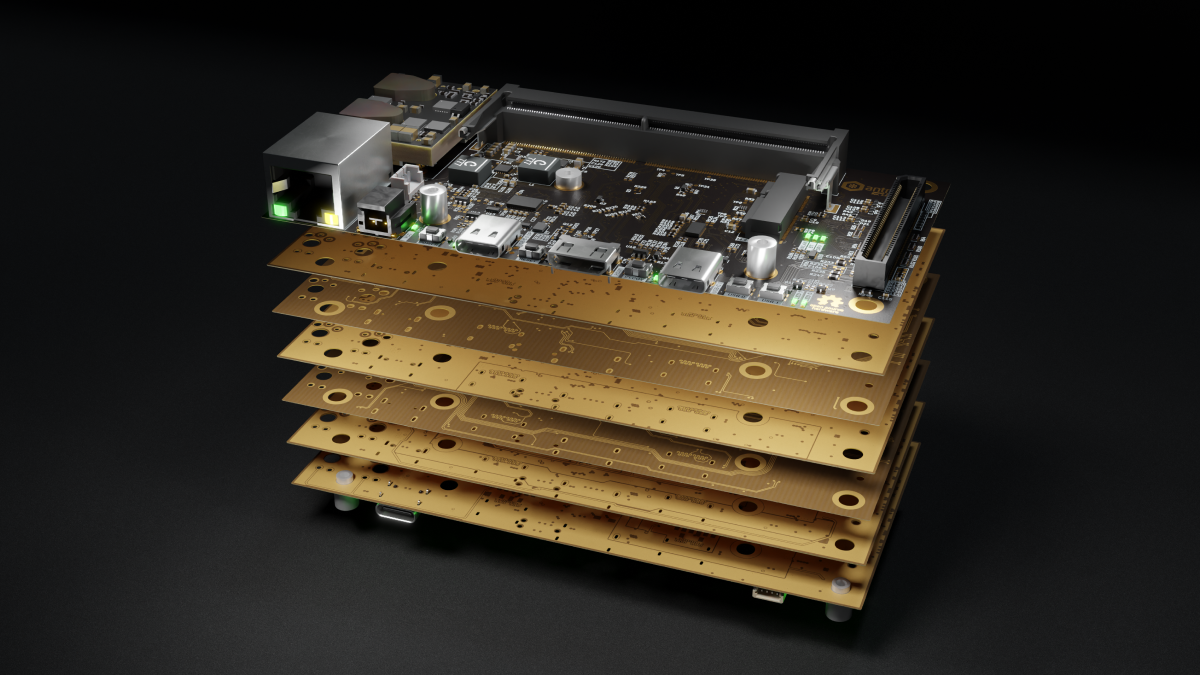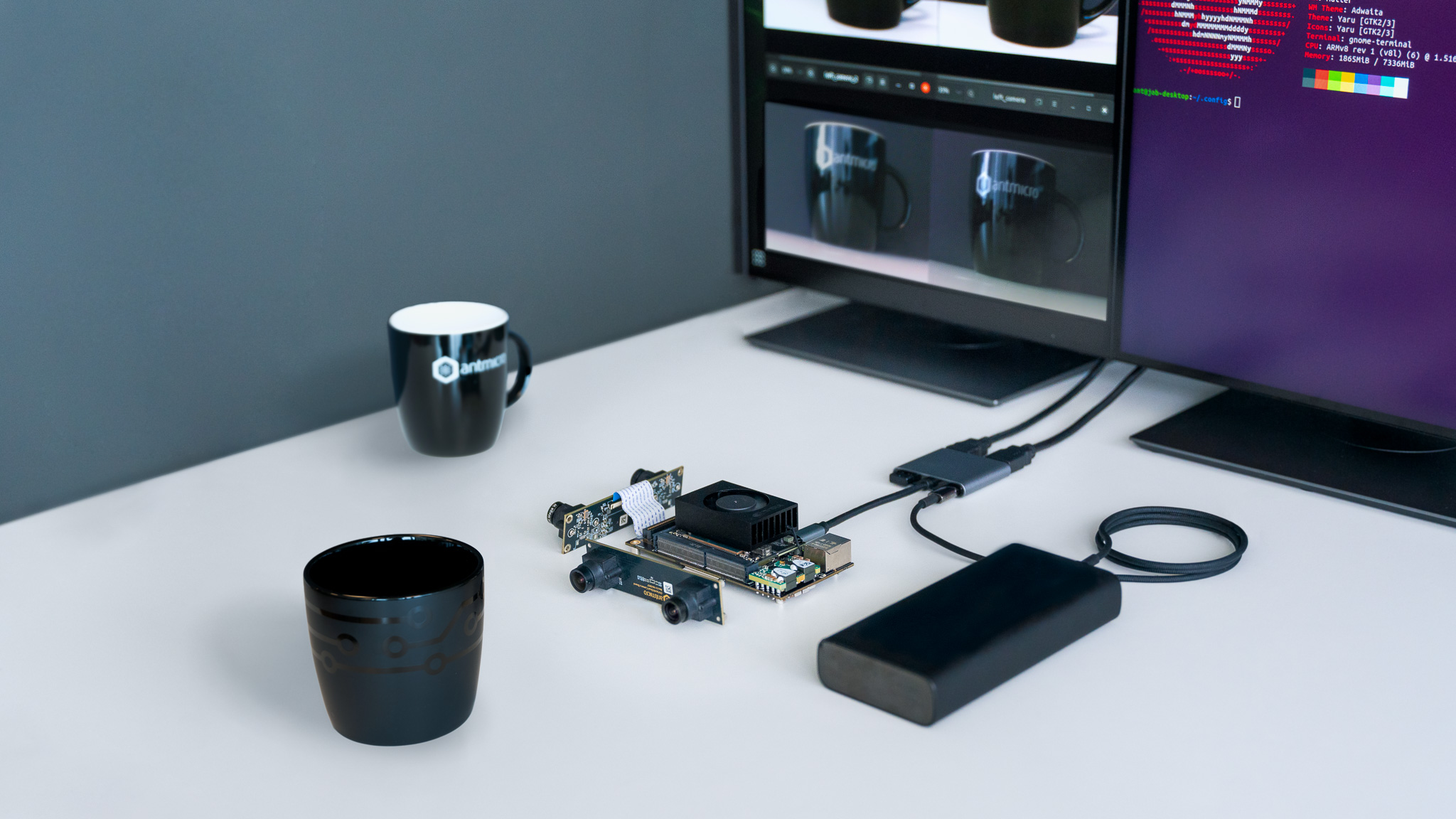Open hardware Jetson Orin Baseboard 1.1 supporting Orin Nano SoM
Published:
Topics: Open hardware, Edge AI
Antmicro’s broad portfolio of open hardware projects includes numerous NVIDIA Jetson-related baseboards and technology demonstrators, built around NVIDIA’s versatile Systems-on-Module ecosystem. The highly popular Jetson Nano Baseboard and the most recent Jetson Orin Baseboard currently support all of the SO-DIMM sized NVIDIA Jetson SoMs: Jetson Nano, Jetson Xavier NX, Jetson TX2 NX and Jetson Orin NX. The baseboards are reliable reference designs for building new products and can be customized and combined with other boards and accessories we created and combined with Antmicro’s software frameworks and services in order to get new products to market much faster.
NVIDIA has recently introduced yet another member of the Jetson family, the Jetson Orin Nano SoM, whose lower price tag compared to Orin NX but vastly improved performance as compared to its previous-gen counterpart, Jetson Nano, makes it a very compelling alternative for building relatively inexpensive but powerful AI-enabled smart devices. The module is available in two versions with a flash size of 8GB and 4GB, providing 40 TOPS and 20 TOPS of AI performance respectively. In its 1.1 revision, the Jetson Orin Baseboard now fully supports the Jetson Orin Nano SoM with a dedicated OE4T kernel and device tree.

Jetson Orin Baseboard rev. 1.1
While both Jetson Orin NX and Jetson Orin Nano share the same pinout, the modules differ in the accepted power supply voltage - they allow 5-20V and just 5V respectively. To avoid potential errors related to using an unsupported power supply voltage with the Orin Nano, we unified the power supply to 5V.
The new revision of the Jetson Orin Baseboard is also backward compatible with other Jetson SoMs, insofar you are using I/O interfaces that are common to all Jetson SoMs.
Revision 1.1 adds an integrated Texas Instruments TS3DV642 multiplexer which allows it to re-route the video output between HDMI and DisplayPort connectors located on the board.
Additionally, we thoroughly tested the USB 3.1 interface offered by Jetson Orin NX with the Texas Instruments TPS65988 power delivery solution. The board can thus now act as a power source for USB-C devices such as display monitors. The board can also be powered over USB-C using standard USB-C chargers or power banks, and supports alternate modes of USB-C offering video outputs also in dual-screen configuration.
Jetson Orin Baseboard in rev. 1.1 exposes the I2C bus and CAN bus for easier interfacing with external sensors and controllers, which speeds up Proof of Concept development with various I2C peripherals or other CAN-connected devices.
Due to the huge interest sparked by the announcement of our initial Jetson Orin Baseboard rev. 1.0 targeting Jetson Orin NX, we tweaked the Bill of Materials (BOM) and component definitions to make the Jetson Orin Baseboard easier to assemble.
The Jetson Orin Baseboard 1.1 has been already included in our Open Hardware Portal, providing you with an in-depth overview of the board and components used in the design. Since, at the time of writing this, only a simplified mechanical model of the Orin SoM was provided by NVIDIA, we decided to make a Blender counterpart.

We are constantly developing our CI-driven visualization flow which combines KiCad design files with the Blender rendering engine, providing flexible and collaborative hardware prototyping capabilities. It allows us to create interactive, completely controllable 3D models of Jetson-driven products, including stackup layers and mechanical arrangements. This fully open source flow is not limited to just electronics but can also be used with enclosures, fastening solutions, cabling and more. You will find more information about that approach in a recent blog note.

Custom BSP for Jetson Orin Baseboard
Both Jetson Orin NX and Jetson Orin Nano are supported in NVIDIA JetPack 5.1 SDK which includes a Ubuntu 20.04.5 based NVIDIA Jetson Linux 35.2.1 root filesystem.
To test the rev 1.1 board, we used Linux kernel 5.10 from the OE4T (OpenEmbedded for Tegra) project and developed a custom device tree, including support for PCI-e x4 and x1 on two M.2 slots, one USB3.2 Type-C host and one device port, 4x OV5640 cameras on two Antmicro OV5640 Dual Camera boards, an I2C multiplexer and a GPIO expander, as well as user buttons and LEDs.
The kernel and devicetree are available on GitHub, and we’re working on integrating them with our own Yocto meta-layer, meta-antmicro.
Orin SoMs use open source UEFI firmware based on EDK II that supports booting from a variety of sources such as NVMe SSD, USB memory stick or over the network using PXE Boot and HTTP Boot protocols. The board has been verified to run from both NVMe SSD and a USB stick.
The picture below shows Jetson Orin NX installed in Jetson Orin Baseboard rev. 1.1, with two OV5640 Dual camera boards attached. The SoM is powered over USB-C from a power bank and uses the same USB-C to drive two displays in dual screen mode. The display presents four preview windows with video streams captured by all four OV5640 imagers.

Jetson Orin Baseboard rev. 1.1 includes two camera interface connectors utilizing MIPI CSI-2 interfaces. Those connectors are electrically compatible with a variety of open source video accessories created by Antmicro:
- Lattice CrossLink-NX driven SDI-MIPI Video Converter
- Lattice CrossLink driven SDI-MIPI Bridge
- CVBS-MIPI Bridge
- HDMI-MIPI Bridge
- OV5640 Dual Camera Board
- OV9281 Dual Camera Board
Tailored solutions for next-gen AI devices
Antmicro’s Jetson Orin Baseboard is a great starting point for your next generation product development, especially coupled with the low-cost Jetson Orin Nano which opens up new application areas which need high AI performance at a reasonable price point.
For customers building new Jetson devices we can develop customized versions of our Jetson Orin Baseboard, including addition/removal of connectors, BoM optimization for large scale production, change of form factor, integration with FPGA preprocessing, adding PCIe peripherals etc. We also offer expertise and resources to build relevant software - Yocto-based BSPs, Over-The-Air (OTA) update system, pipelines for image processing, streaming and AI-based analysis, all customized to your application. If you are building a device which incorporates the Orin Nano, don’t hesitate to contact us at contact@antmicro.com and see how we can help.
